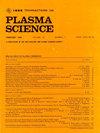Investigation of Current-Carrying Oblique Impacts on the Copper–Aluminum Interface for Damage Characteristics
IF 1.3
4区 物理与天体物理
Q3 PHYSICS, FLUIDS & PLASMAS
引用次数: 0
Abstract
The gouging seriously affects the reliability and the life of railguns, and oblique impact is considered the main reason for gouging. In this article, a pulse power technology method for the current-carrying oblique impact using an electromagnetic (EM) repulsive disk was proposed. The strain rate of铜铝界面上的载流斜撞击损伤特征调查
刨伤严重影响了轨道炮的可靠性和寿命,而斜撞击被认为是造成刨伤的主要原因。本文提出了一种利用电磁斥力盘进行载流斜冲击的脉冲功率技术方法。通过数值模拟得到试样上的应变速率为 1.5times 10^{4}$ /s,电流密度为 2.48times 10^{9}$ A/m2 。研究了高电流密度和高应变速率下 AA7075 与 T2 铜接触界面的动态冲击损伤和沉积特性。通过比较不同电流密度下试样轮廓和表面的微观特征分布,得出以下结果。该方法能够产生类似刨削的凹坑。凹坑底部的变形区域表现出明显的晶粒拉长和细化。随着电流的增加,凹坑深度和变形层厚度逐渐增加。脉冲电流的应用刺激了铝的沉积和新相的出现。电流对机械性能的影响表现在凹坑底部硬度和屈服应力的降低。
本文章由计算机程序翻译,如有差异,请以英文原文为准。
求助全文
约1分钟内获得全文
求助全文
来源期刊

IEEE Transactions on Plasma Science
物理-物理:流体与等离子体
CiteScore
3.00
自引率
20.00%
发文量
538
审稿时长
3.8 months
期刊介绍:
The scope covers all aspects of the theory and application of plasma science. It includes the following areas: magnetohydrodynamics; thermionics and plasma diodes; basic plasma phenomena; gaseous electronics; microwave/plasma interaction; electron, ion, and plasma sources; space plasmas; intense electron and ion beams; laser-plasma interactions; plasma diagnostics; plasma chemistry and processing; solid-state plasmas; plasma heating; plasma for controlled fusion research; high energy density plasmas; industrial/commercial applications of plasma physics; plasma waves and instabilities; and high power microwave and submillimeter wave generation.
 求助内容:
求助内容: 应助结果提醒方式:
应助结果提醒方式:


